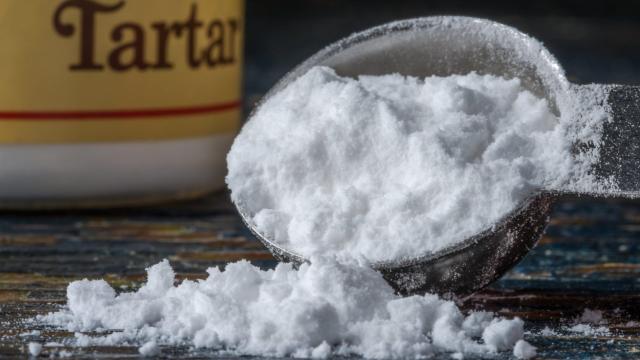Cream of tartar is an incredibly useful ingredient. With it, you can stabilise whipped cream, make your own baking powder, and cook up extra-fluffy scrambled eggs. There is, however, a fairly widespread misunderstanding of what it is.
If you type “what is cream of tartar” into a popular search engine, you will get a whole slew of articles and blogs that tell you it is tartaric acid. This is technically incorrect, but that’s ok because it gives me an opportunity to talk salts, one of my favourite topics. While not pure tartaric acid itself, cream of tartar is the potassium salt of tartaric acid, meaning there is a potassium atom where a hydrogen atom used to be. The chemical formulas for cream or tartar and tartaric acid are KC4H5O6 and C4H6O6 respectively. (Note that the acid has one more H.)
Tartaric acid occurs naturally in citrus fruits, bananas, tamarind, and — somewhat famously — grapes. It’s a major player in wine production, and affects the wine’s colour, mouthfeel, and flavour, and lowers the pH during fermentation, preventing the growth of harmful bacteria.
The solubility of tartaric acid is fairly temperature-dependent. At temperatures lower than 4C, free tartaric acid partners up with naturally occurring potassium, forming a salt and precipitating out to form “wine diamonds” in the barrel and (sometimes) on the cork of an especially chilled bottle. Those crystals are cream of tartar (aka, potassium bitartrate or potassium acid tartrate). They largely go unnoticed in red wine, which is rarely chilled below 4C and is prone to sediment anyway, but it can be quite alarming in a white. If you see the little crystals, don’t panic, they’re completely harmless. Just filter them out.
You are unlikely to find pure tartaric acid in the grocery store, although it can be ordered from molecular gastronomy-type suppliers (and Amazon). Tartaric acid can be used as an acidulant (meaning it makes things taste sour), or as a preservative (by lowering the pH). It’s used in a lot of sour, fruit-flavored candy, which is some of my favourite candy.
Cream of tartar is incredibly common (and, as long as you keep it dry, very shelf-stable), and can be found in nearly any common grocery store. When mixed with water and baking soda (an alkaline ingredient), cream of tartar provides the acid in the acid-base reaction that releases carbon dioxide bubbles, and those bubbles are what cause your baked goods to rise. (This is probably where the “cream of tartar is tartaric acid” confusion comes from. Even though it is not pure tartaric acid, it is still an acidic salt, and acts as an acid when dissolved in water and introduced to a base.)
In addition to leavening, cream of tartar can also be used to stabilise whipped proteins (or foods that contain protein), such as cream or egg whites. It lowers the pH (and introduces more hydrogen ions), which changes the charge of the proteins and keeps them from bonding too tightly. According to Slate, this keeps the proteins “aligned but not jammed together too tightly,” and “the structure keeps the water and air bubbles in place, and therefore is stronger and more secure,” but still “supple and elastic.” (Smearing yourself with cream of tartar will not, unfortunately, make you more supple and elastic, although it can work wonders on an old plate or metal appliance.)

Leave a Reply
You must be logged in to post a comment.